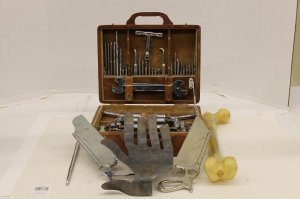Orthopedics is the medical specialty concerned with the preservation and restoration of function of the skeletal system and its associated structures, such as spinal and other bones, joints, and muscles.
The term orthopedics was first introduced in 1741 by the French physician Nicolas Andry de Bois-Regard in his work "L'Orthopedie", which featured an engraving of a crooked tree splinted with a post and rope that later became a symbol of the field. The practice of orthopedics was pioneered in later decades by Jean Andre Venel. During the 19th century significant advances were made in the field of orthopedics with inceased knowledge of muscular functions, bone development and bone growth. This increased knowledge resulted in an advancement of orthopedic procedures helping to correct deformities such as clubfoot.
The invention of the Thomas splint and the introduction of quick setting plaster of Paris was another significant advancement in the practice of orthopedics.
Modern orthopedics has gone beyond the treatment of fractures, broken bones, strained muscles, torn ligaments and tendons to deal with a wide range of acquired and congenital skeletal deformities and with the effects of degenerative diseases such as osteoarthritis.
Originally depending on the use of heavy braces and splints, orthopedics now utilizes bone grafts and artificial plastic joints for the hip and other bones damaged by disease, as well as artificial limbs, special footwear, and braces to assist patients with mobility.
The collection at Edward Hand Medical Heritage Foundation includes a wide variety of orthopedic instruments from a early as the mid 19th century to the early 21st century.
